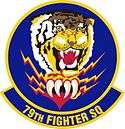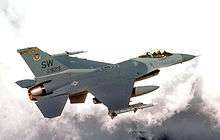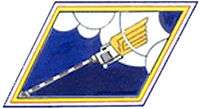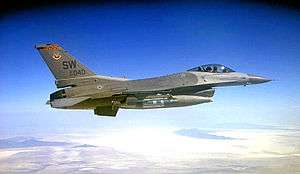79th Fighter Squadron
| 79th Fighter Squadron | |
|---|---|
|
79th FS F-16C Block 50 94-0049 flies a mission over the Utah Test and Training Range, 2002 | |
| Active |
22 February 1918 – 15 November 1918 1 April 1933 – 18 October 1945 29 July 1946 – 30 June 1993 1 January 1994 – present |
| Country | United States |
| Branch | United States Air Force |
| Type | Fighter |
| Part of |
Air Combat Command 9th Air Force 20th Fighter Wing 20th Operations Group |
| Garrison/HQ | Shaw Air Force Base |
| Nickname(s) | Tigers |
| Engagements | Battle of Normandy |
| Decorations |
|
| Commanders | |
| Notable commanders |
James Ferguson James E. Hill John G. Lorber |
| Insignia | |
| 79th Fighter Squadron emblem |
 |
The 79th Fighter Squadron (79 FS) is part of the 20th Fighter Wing at Shaw Air Force Base, South Carolina. It operates the F-16 Fighting Falcon aircraft conducting air superiority missions.
The squadron is one of the oldest in the United States Air Force, its origins dating to 22 February 1918, being organized at Rich Field, Waco Texas, as a pilot training Squadron during World War I. The squadron saw combat during World War II, and became part of the United States Air Forces in Europe (USAFE) during the Cold War.
History



The 79th Fighter Squadron traces its history back to February 1918, when it was first organized as the 79th Aero Squadron. The unit inactivated from November 1918 until April 1933, when it became the 79th Pursuit Squadron, flying the Boeing P-12 at Barksdale Field, Louisiana From 1940 to 1942, the squadron trained combat pilots and flew the P-40 Warhawk from bases on the east coast.[1]
In 1943, the 79th converted to the P-38 Lightning, flying out of Northamptonshire, England, performing duty as bomber escorts and conducting fighter sweeps over Germany. The 79th remained at English bases throughout the war, supporting both the Normandy invasion and the allied drive into Germany. The squadron returned to the states and was inactivated on 19 October 1945.[1]
The 79th was again brought to active service on 29 July 1946, at Biggs Field, Texas. The unit moved to Shaw Field, South Carolina, in October 1946. The squadron moved again to Langley Air Force Base, Virginia, in November 1951, and in June 1952, trained to support NATO ground forces in conventional and nuclear roles arriving at RAF Woodbridge England 1st October 1952 flying first the F-84G Thunderjet and then in 1955 the swept wing F-84F Thunderstreak. Redesignated as the 79th Tactical Fighter Squadron the unit transitioned onto the F-100 Super Sabre in 1957 and shared RAF Woodbridge with the 78th TFS (part of the 81st TFW) and operated locally under the command of the 81st TFW which was based at nearby RAF Bentwaters. The next change came in 1970, when the squadron transitioned to the F-111E Aardvark and moved to RAF Upper Heyford, England. The 79th received the Commander in Chief’s Trophy in 1981, as the best tactical fighter squadron in U.S. Air Forces in Europe.[1]
From 1990 to 1991, the 79th deployed to Southwest Asia to support Operations Desert Shield and Desert Storm. On 30 June 1993 the squadron inactivated. On 1 January 1994, it was reactivated at Shaw Air Force Base, South Carolina, transitioning to the F-16 Fighting Falcon and assuming the mission of suppression of enemy air defenses. Since that time, the 79th has continuously supported Operations Northern and Southern Watch in Southwest Asia.[1]
In December 1998, the 79th took an active part in Operation Desert Fox in conjunction with Operation Southern Watch demands. The squadron flew more than 1,000 successful combat sorties with these dual operational requirements. In January 1999, the 79th Fighter Squadron was awarded the South Carolina Air Force Association’s Outstanding Air Force Unit of the Year award. Also in 1999, the squadron was honored with Air Combat Command’s Maintenance Effectiveness Award. In June 1999, the 79th deployed F-16CJs in support of Operation Allied Force to a bare base in Southwest Asia.[1]
2013 Sequestration
Air Combat Command officials announced a stand down and reallocation of flying hours for the rest of the fiscal year 2013 due to mandatory budget cuts. The across-the board spending cuts, called sequestration, took effect 1 March when Congress failed to agree on a deficit-reduction plan.[2]
Squadrons either stood down on a rotating basis or kept combat ready or at a reduced readiness level called “basic mission capable” for part or all of the remaining months in fiscal 2013.[2] This affected the 79th Fighter Squadron with a reduction of its flying hours, placing it into a basic mission capable status from 5 April-30 July, then returning it to combat mission ready through September 2013.[2]
Lineage
- Organized as 79th Aero Squadron on 22 Feb 1918
- Re-designated Squadron B, Hicks Field, TX, on 23 Jul 1918
- Demobilized on 15 Nov 1918
- Constituted as 79th Observation Squadron on 18 Oct 1927
- Re-designated: 79th Pursuit Squadron on 8 May 1929
- Organized in the Reserve on 7 September 1932[3]
- Activated in the Army Air Corps on 1 Apr 1933[3]
- Consolidated with Squadron B, Taliaferro Field, 25 May 1933
- Re-designated: 79th Pursuit Squadron (Fighter) on 6 Dec 1939
- Re-designated: 79th Pursuit Squadron (Interceptor) on 12 Mar 1941
- Re-designated: 79th Fighter Squadron on 15 May 1942
- Re-designated: 79th Fighter Squadron (Twin Engine) on 30 Dec 1942
- Re-designated: 79th Fighter Squadron, Twin Engine, on 20 Aug 1943
- Re-designated: 79th Fighter Squadron, Single Engine, on 5 Sep 1944
- Inactivated on 18 Oct 1945
- Activated on 29 Jul 1946
- Re-designated: 79th Fighter Squadron, Jet, on 15 Jun 1948
- Re-designated: 79th Fighter-Bomber Squadron on 20 Jan 1950
- Re-designated: 79th Tactical Fighter Squadron on 8 Jul 1958
- Re-designated: 79th Fighter Squadron on 1 Oct 1991
- Inactivated on 30 Jun 1993
- Activated on 1 Jan 1994.[4]
Assignments
- Post Headquarters, Rich Field, 20 Feb 1918[5]
- Post Headquarters, Hicks Field, Feb 1918
- Post Headquarters, Barron Field, March-18 Nov 1918[5]
- VIII Corps Area, 18 October 1927 – 8 May 1929[3]
- 20th Pursuit (later, 20th Fighter) Group, 25 May 1933-18 Oct 1945
- 20th Fighter (later, 20th Fighter-Bomber) Group, 29 Jul 1946
- Attached to: 20th Fighter-Bomber Wing, 15 Nov 1952-7 Feb 1955
- 20th Fighter-Bomber (later, 20th Tactical Fighter) Wing, 8 Feb 1955
- Attached to: 39th Tactical Group, 1-31 Aug 1990 and Feb 1991
- 20th Operations Group, 31 Mar 1992-30 Sep 1993; 1 Jan 1994-present [4]
Stations
|
|
Aircraft
|
|
See also
References
![]() This article incorporates public domain material from the Air Force Historical Research Agency website http://www.afhra.af.mil/.
This article incorporates public domain material from the Air Force Historical Research Agency website http://www.afhra.af.mil/.
- 1 2 3 4 5 79 FS Fact Sheet
- 1 2 3 Reduced flying hours forces grounding of 17 USAF combat air squadrons
- 1 2 3 Clay, Steven E. (2011). US Army Order of Battle 1919–1941. 3 The Services: Air Service, Engineers, and Special Troops 1919–1941. Fort Leavenworth, KS: Combat Studies Institute Press. ISBN 978-0-98419-014-0. LCCN 2010022326. OCLC 637712205
- 1 2 3 4 AFHRA 79 FS Page
- 1 2 Order of Battle of the United States Land Forces in the First World War, Volume 3, Part 3, Center of Military History, United States Army, 1949 (1988 Reprint)
- ↑ 77th Fighter Squadron at F-16.net
External links
| Wikimedia Commons has media related to 79th Fighter Squadron (United States Air Force). |

